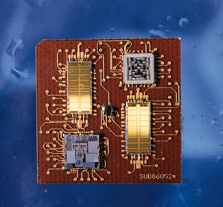Seal the Deal
Adding more reliability to electronic parts is always of foremost interest to high-tech manufacturers. A two-year study has mastered a process technology to render plastic encapsulated electronics modules more resistant to moisture and environmental contaminants.
AvanTeco, Whittier, California, and Revtek, Inc., of Torrance, California, now produce, market, and sell a newly-devised coating method for electronic packaging. This technology was brought to fruition through Small Business Innovation Research (SBIR) contracts from the Jet Propulsion Laboratory (JPL). This novel work was initially performed by Engineering Technologies Associates of Laguna Hills, California.
Considered risky is the packaging of electronic parts in low-cost plastics. While fine for most commercial devices, plastic packaging of critical electronic circuits within expensive spacecraft and medical equipment required further reliability studies. The approach taken by researchers was to originate an overcoat for circuits with an inorganic moisture barrier. A low temperature vacuum deposition process that was non-damaging to underlying epoxy and the assembled circuit proved a workable solution. This overcoating reduced moisture absorption of encapsulated samples. Also, the dual coating had low weight loss in thermal vacuum and low toxicity level as tested to NASA specifications.
Over 90 percent of all integrated circuits produced today are either transfer molded or liquid encapsulated in epoxy plastic. Multimillions of these plastic-packaged chips are produced each day for the consumer and commercial electronics markets. They perform reliably for the intended environments. However, with the emergence of large, very high density, high speed chips, new concerns about the use of plastic encapsulation have been raised.
Making this issue more debatable is the drive to reduce costs of civilian and military hardware, an approach that calls for use of commercial off-the-shelf electronics, or COTS for short. Therefore, enhancing circuit reliability through use of protective coatings, instead of hermetically-packed integrated circuits, has become increasingly suggested. But there are several problems to this approach, one being the exposure of plastic-packaged parts to high humidity at extreme temperatures. Plastics, no matter how good, are permeable to moisture over time, which can then penetrate to the interior of the device and cause a catastrophic failure.
JPL-supported research teams evaluated candidate organic and inorganic barrier coatings and chemically inert plastics. The winning combination? Applying an inorganic barrier coating over the plastic, a technique that greatly reduces moisture penetration and improves reliability. A process was then developed for overcoating epoxy encapsulated circuits with a secondary inorganic dielectric film for added moisture protection. To increase long-term moisture resistance, adhesion between coatings was optimized.
The dual coating approach is expected to add moisture protection to commercial epoxy-coated parts at low added cost, and to reduce packaging cost for many high reliability circuits for space, military, and medical use.
SBIR contract work also yielded a low-cost and easily tested moisture and contamination sensor chip. It acts as a "moisture fuse," says Dr. James Licari, President of AvanTeco. "Once moisture has completely penetrated to the active surfaces of a plastic encapsulated module, the device will short out," he says. "However, using this failure mechanism in a beneficial way detects the penetration of moisture and ionic contaminants through the plastic or into a hermetically sealed enclosure. The failure of the chip is an alert that moisture has penetrated the circuit surface and that the circuit is at risk due to corrosion or other moisture-induced failure," Licari says. The moisture sensor chips were developed jointly by AvanTeco and Revtek, and are being produced and sold by Revtek.

High-value electronic circuitry can be overcoated with an inorganic moisture barrier. Shown is a circuit board, replete with an alert chip (center) that signals if moisture has penetrated the circuit surface.













